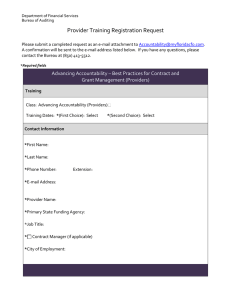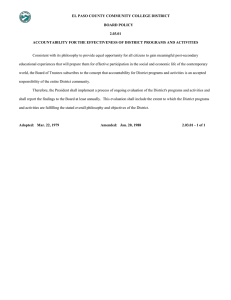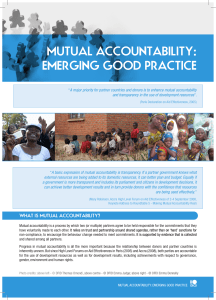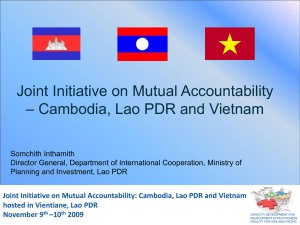Timothy Lubanga
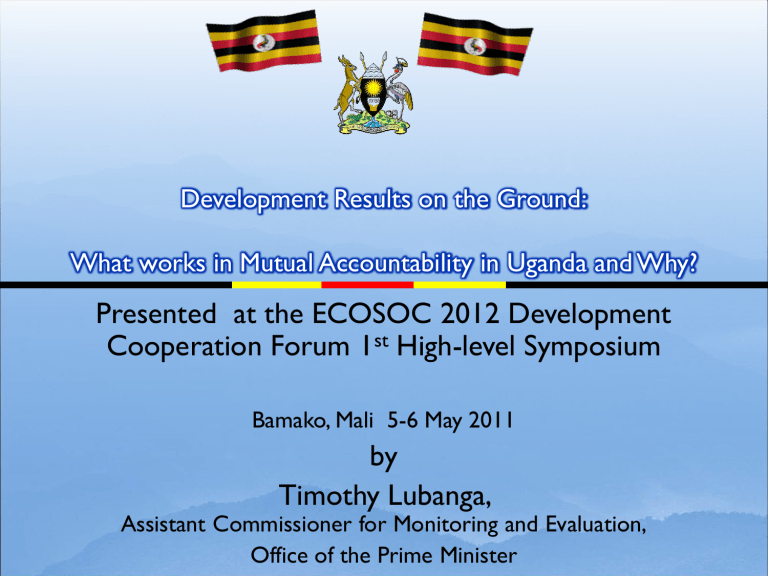
Development Results on the Ground:
What works in Mutual Accountability in Uganda and Why?
Presented at the ECOSOC 2012 Development
Cooperation Forum 1 st High-level Symposium
Bamako, Mali 5-6 May 2011 by
Timothy Lubanga,
Assistant Commissioner for Monitoring and Evaluation,
Office of the Prime Minister
Outline of the presentation
Introduction
Key Elements of The Mutual Accountability
Framework
Implications of Monitoring Framework
Key messages and lessons
2
Introduction of the JBSF
History of Aid coordination mechanisms with varying degrees of success
Government Performance Management Framework
Joint Budget Support Framework (JBSF) - long-term, transparent and predictable framework for providing budget support that
Use of the National Performance Assessment System and Joint
Assessment Framework
Harmonize Performance assessments
Align budget support decisions to the national budget processes
Improve the impact of Government spending and reduce transaction costs in the delivery of aid.
New Partnership Policy sets out guiding principles and priorities to manage the relationship with its Development Partners, within the context of the National Development Plan (NDP)
3
The key elements of Mutual Accountability
Framework
Partnership Policy
Highlights 4 broad objectives to improve the effectiveness of development cooperation through greater government ownership and leadership, strengthen economic management, accountability and policy coherence
Articulates the principles and the country’s policies on development cooperation
Highlights the roles of the various actors in the process of aid management and coordination
Contains a Monitoring Framework with a set of indicators for both development partners(donors) and government to be agreed upon by the parties and monitored on a regular basis
4
The key elements of Mutual Accountability
Framework
Enhanced coordination by Government, with leadership provided at a high policy level
Joint performance assessment based on a National
Performance Assessment built on extensive sectoral reviews
Focus on results and Value for Money
Time table that is linked to the national budget cycle
Memorandum of Understanding to be signed with donors based on the Framework
The use of key sectors to lead the process
5
The key elements of Mutual Accountability
Framework
Policy preconditions for effective and efficient implementation of Government policies
Cross-cutting policy reforms to tackle systemic performance impediments
Specific actions in service delivery sectors (Health,
Education,Water and Roads)
Mutual Accountability (Indicators being defined). There will be indicators for each development partner within the framework
Building on participation and leadership by Parliament,
CSOs Government at highest level (AAA)
6
Implications of MA Mechanism
The commitments under this framework are not just for the sectors mentioned, but for the entire Economy, inclusiveness
Effective peer pressure effect
National ownership of the exercise as emphasized in AAA
Monitoring Framework contains manageable number of indicators (52) for the Country and Development
Partners (donors). Each sector has just 3 indicators
Improvement in development results in the key service delivery sectors
7
Messages and Lessons
Strengthening of the Government Coordination and performance management structures
Increased participation of the civil society and local governments in the discussions as well as Cabinet
Provides an opportunity to review progress and address challenges to improve performance
Platform for enhancing accountability to Parliament and by
Parliament
Improved learning within and across sectors
8
Key Messages and Lessons
Improved dialogue between Government and
Development Partners
More predictable Budget Support, hence better planning, budgeting e.t.c
Strengthening Government systems – capacity development
Improved performance by sectors concerned
Reduced transaction costs
Harmonization
9
End
Thank you

